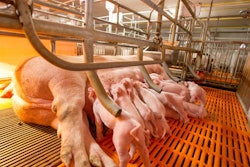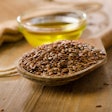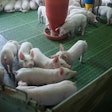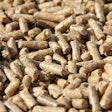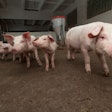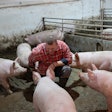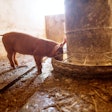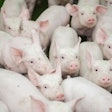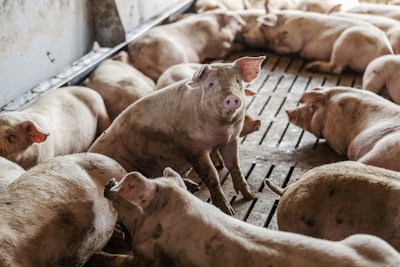
Pigs are marketed somewhere between 110 and 130 kilograms of body weight, depending on region, prices and demand. A couple of decades ago, pigs rarely exceeded 95 kilograms at market age, but genetic improvement has greatly increased this number and I expect it to only go up in the decades ahead. But, today, 120 kilograms is the golden average for most places in the world.
The reason we do not feed our pigs to heavier weights is because, after a certain point, they reach their maximum daily protein deposition rate (lean meat) and start the declining process. This does not mean they don’t continue to grow, but lean growth slows down considerably. At the same time, backfat deposition starts to exceed what we call minimum lipid deposition rate and, as age and weight increase, fat deposition accelerates with alarming speed. Thus, a pig finishing at 150 kilograms will have unacceptable carcass characteristics by today’s standards. Interestingly, the same was true for 95-kilograms genetics finishing at 120 kilograms a couple of decades ago. Thus, it is only the numbers that have changed, and not the biology of the pig.
Need for super-heavy pigs
Despite the above, there is a need for super-heavy pigs, which I place at 150 kilograms live weight. First, we have the Parma pigs, but this is a niche market where the extra fat is useful as it serves a role. It protects the Parma hams during their maturing process. But, this article is not about Parma pigs, but rather for normal meat consumption from heavy pigs.
Today, there is a need (often localized) for extra pig meat that cannot be imported (too-expensive transportation) or is just unavailable even for importation. This is due to several reasons, and I will mention only three of them: an extensive drought that increased the price of grains, forcing many pig farmers out of business; the ongoing war at the Eastern part of Europe continues to put pressure and uncertainty on cereal prices, again forcing less financially stable pig farmers out of business; and the persisting inflation has made pig farming rather a hobby than a business in several parts of the world – at least until meat prices increase considerably. There are regions, such as the U.S., where pig meat is abundant and prices are cheap, but that may as well turn upside down as it has happened so many times in the past.
Feeding pigs to 150 kilograms
After about 120 kilograms of body weight, we see in most genetics today a sharp increase in feed intake. This is an empirical observation that has been related to me by many of my customers. Feeding a normal (corn-soy) diet does not work because we have to face two problems:
1. If we just lower protein (soy/amino acids) to match the amino acid requirements, the remaining part of the diet will be corn, which is full of energy. With a huge appetite, this would cause pigs to become overly fat (lard pigs of old times.)
2. If we do not lower protein, or even increase it (as some suggest), we will have animals burning calories to excrete the surplus nitrogen. They may not become overly fat, but the cost of production will be unbearable. This kind of diet was used by humans to lose weight (fat), but even there it is no longer recommended.
Feed restriction remains a challenge
In the past, when we needed heavier pigs with fat(ter) genetics, we had to limit their feed intake manually. Today, such systems are no longer as widespread as they used to be (especially in the British islands) and most pigs are fed ad libitum. So, finding a way to restrict their daily feed allowance with ad libitum feeders is rather a futile exercise – not impossible, but rather impractical as it involves much human (sophisticated) labor. Perhaps this is possible with liquid or computerized feeding, but these are not as widespread as we may believe. Still, most pig farmers depend on simple feeders offering simple dry diets in meal form. So, we are stuck with ad libitum feeding systems and a need to take pigs to 150 kilograms without being unbearably fat.
Energy dilution as the last resort
I will not say (again) that something is easy, just because personally I have the means of doing it, but I will say it is difficult without the proper knowledge (same thing, but it will spare me another diplomatic quarrel). So, yes, it is possible to bring modern pigs to 150 kilograms live weight, but you will need the help of an experienced nutritionist for that.
This is, roughly, how it is done; however, each case is very specific and needs prior examination:
1. Protein is reduced to cover the needs for the diminishing lean deposition. This will ensure the feed remains reasonably priced.
2. To satisfy the appetite for more feed (volume/mass), we bring into the formulation a source of roughage (fiber) that offers very little in terms of energy. The exact level will depend on the available ingredients.
3. We avoid high-fiber ingredients that are rich in protein and/or energy, and especially those that can be a source of mycotoxins.
4. Quite often, these high-fiber materials come in pre-pelleted form. There is no need to grind them unless they are super hard. The extra texture and the time spent chewing the pellets will satisfy the instinct for extra feed.
5. We change the electrolyte balance to keep pigs calm and hydrated to avoid the sudden-death syndrome that can be attributed to many reasons and affects the best pigs in a lot.
6. We unburden the formula from additives and other supplementary nutrients that are no longer needed so as to ease their metabolic stress at such heavy weights.
Heavy pigs are possible, some extra fat is unavoidable, and the way to do it is to think out of the box and consider not only growth and feed intake but also animal health and well-being – especially if such exercise is done during summer where heat adds an extra stress factor.


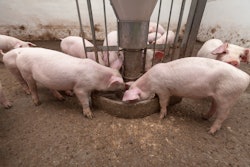
![Pigs Swine[1]](https://img.feedstrategy.com/files/base/wattglobalmedia/all/image/2023/05/pigs_swine_1_.645ea20ff2e67.png?auto=format%2Ccompress&fit=crop&h=167&q=70&w=250)
